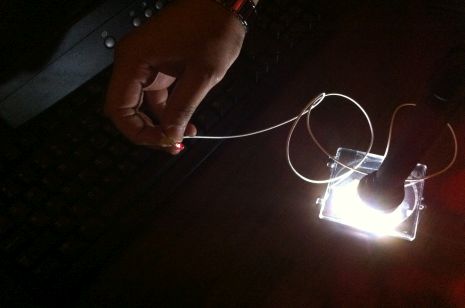
FAYETTEVILLE, Ark. – Engineering researchers at the University of Arkansas have achieved the highest efficiency ever in a 9 millimeter-squared solar cell made of gallium arsenide. After coating the cufflink-sized cells with a thin layer of zinc oxide, the research team reached a conversion efficiency of 14 percent.
A small array of these cells – as few as nine to 12 – generate enough energy for small light-emitting diodes and other devices. But surface modification can be scaled up, and the cells can be packaged in large arrays of panels to power large devices such as homes, satellites, or even spacecraft.
The research team, led by Omar Manasreh, professor of electrical engineering, published its findings in Applied Physics Letters and the April 2014 issue of Solar Energy Materials and Solar Cells.
An alternative to silicon, gallium arsenide is a semiconductor used to manufacture integrated circuits, light-emitting diodes and solar cells. The surface modification, achieved through a chemical synthesis of thin films, nanostructures and nanoparticles, suppressed the sun’s reflection so the cell could absorb more light. But even without the surface coating, the researchers were able to achieve 9-percent efficiency by manipulating the host material.
“We want to increase the efficiency of small cells,” said Yahia Makableh, doctoral student in electrical engineering. “With this specific material, the theoretical maximum is 33 percent efficiency, so we have some work to do. But we’re making progress. The beauty of zinc oxide is that it’s cheap, non-toxic and easy to synthesize.”
Makableh said the surface modification could also be applied to other solar cells, including those made of indium-arsenide and gallium-arsenide quantum dots. Solar cells made of these materials may be able to achieve 63-percent conversion efficiency, which would make them ideal for future development of solar cells.
Makableh used equipment and instrumentation in the College of Engineering’s Optoelectronics Research Lab, which is directed by Manasreh. Researchers in the lab grow and functionalize semiconductors, nanostructured anti-reflection coatings, self-cleaning surfaces and metallic nanoparticles to be used in solar cells. Their ultimate goal is to fabricate and test photovoltaic devices with greater solar-energy conversion efficiency.
Manasreh focuses on experimental and theoretical optoelectronic properties of semiconductors, superlattices, nanostructures and related devices. Since joining the University of Arkansas in 2003, he has received more than $8 million in public research funding from the National Aeronautics and Space Administration, the U.S. Air Force and the National Science Foundation.
Topics
Contacts
Yahia Makableh, doctoral student, electrical engineering
College of Engineering
479-966-6728, ymakable@email.uark.edu
Omar Manasreh, professor, electrical engineering
College of Engineering
479-575-6053, manasreh@uark.edu
Matt McGowan, science and research communications officer
University Relations
479-575-4246,
dmcgowa@uark.edu